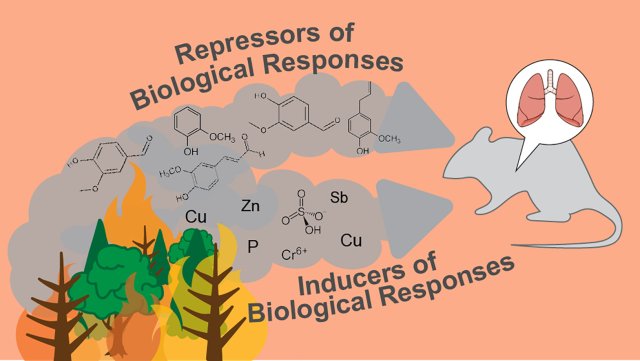Wildland Fire Research: Human Health
As the number of acres burned from wildfire has increased, so has the amount of smoke emitted, increasing the extent of the U.S. population exposed to smoke. Smoke contributes to poor air quality in communities both near and far from a wildfire as smoke can travel hundreds to thousands of miles. Wildfire smoke is associated with a range of health effects, from less serious such as coughing and runny nose, to more serious such as respiratory and cardiovascular disease exacerbation, and even premature death. Additionally, some people may be at increased risk of experiencing health effects in response to smoke exposure or experience higher smoke exposures compared to others, which can be detrimental to their health.
On this page:
- Toxicity of Smoke from Peat, Eucalyptus, and Oak Fires
- Peat Smoke and Cardiovascular Health
- Peat Smoke and Cardiorespiratory Health
- Wildfire Smoke and Cardiovascular Health
- Toxicity of Wildland Fire Smoke Mixtures
- Toxicity of Smoke from Burning Anthropogenic Materials
- Wildfire Smoke and Brain Function
- Future Directions
Toxicity of Smoke from Peat, Eucalyptus, and Oak Fires

How can we understand the public health implications of exposure to smoke from peat, eucalyptus, and oak fires?
EPA researchers developed a purpose-built automated furnace system to precisely control the burning of three different biomass fuels (eucalyptus, peat, and red oak) representing the biomes of different regions of the U.S. under two combustion conditions (flaming and smoldering). By using this system, researchers could carefully monitor and ensure stable biomass smoke concentrations in the inhalation chamber and thus test the toxicity on mice.
This study helps to understand how smoke may differ across regions of the U.S. based on the ecosystem impacted and whether there are differences in biological responses to the smoke. This could help us understand whether the exposure reduction measures being used are effective, regardless of smoke composition.
Also, the novel furnace system produces reproducible and reliable biomass smoke inhalation toxicity data, which can be broadly applied in future studies, possibly to in vitro cell-based samples, which would reduce the need for animal-based studies.
Peat Smoke and Cardiovascular Health
Smoke from peat fires can be a significant source of wildfire emissions for certain regions of the U.S. What are the effects of a single exposure to peat smoke on heart health, such as cardiac arrest risk?
EPA researchers generated peat smoke using an automated control tube furnace system and exposed rats once for a duration of 1 hour. A single exposure to peat smoke produced markers of inflammation such as a rise in LDL cholesterol. Systolic and diastolic blood pressure showed an immediate rise upon smoke exposure, but the magnitude depended on peat smoke concentrations. Interestingly, exposure to low peat increased blood pressure, but there was no significant change to heart rate with high peat exposure.
Findings demonstrate that a single exposure to peat smoke has the potential to produce changes in cardiovascular function. Future studies could help identify the most offending chemical constituents of peat smoke and other biomass combustion emissions, as well as examine further how inflammatory markers change over time.
Peat Smoke and Cardiorespiratory Health
In June 2008, smoke from burning peat deposits exposed rural communities in eastern North Carolina to haze and air pollution exceeding the National Ambient Air Quality Standards. What were the cardiorespiratory outcomes of those affected by the smoke?
EPA researchers obtained data for emergency department (ED) visits for cardiac and respiratory conditions and combined with satellite data (provided measurements of aerosol optical depth to determine 3-day windows of high exposure). There is a consistent increase in relative risk in the exposed counties for nearly all outcome categories during and up to 5 days after exposure to wildfire smoke.
This is the first study to demonstrate both respiratory and cardiac effects after brief exposure to peat wildfire smoke. The increase in relative risk in the exposed counties is striking and has potentially significant public health implications, including how public health officials can raise awareness of health risks and improve their response efforts.
Wildfire Smoke and Cardiovascular Health
Does exposure to wildfire smoke increase the risk of out-of-hospital cardiac arrest (OCHA)?
Smoke exposures from wildfires likely have the potential to trigger fatal and near-fatal cardiac arrest. The highest risk is on the heaviest smoke days, but risk persists for several days after. Lower socioeconomic status appeared to increase the risk. Both sexes and age groups 35 years and older were impacted on days with heavy smoke.
This was the first study in the U.S. to examine OHCA and wildfire smoke. As wildland fires become more frequent, more of the population will be exposed to smoke. Understanding the risk factors for adverse cardiovascular effects can help public health practitioners, especially those caring for the elderly and the most vulnerable populations, advise their patients about the risks of air pollution from wildland fire smoke.
Related Resources
US EPA’s Learn about the Particle Pollution and Your Patients' Health Course
Toxicity of Wildland Fire Smoke Mixtures

Wildfire smoke is a complex mixture of particulate matter (PM) and toxic gases that can cause a variety of health outcomes. Can we identify which chemicals (or mixtures of them) are primarily responsible for toxicity, and can these be used as common markers of exposure across different regions in the U.S.?
Researchers used a purpose-built automated furnace system to burn five types of biomass fuel representing the biomes of different regions of the U.S. under two combustion conditions. A total of 86 chemicals were detected across the 10 resulting biomass smoke samples.
While individual chemicals may have a small exposure effect, a mixtures modeling approach allowed researchers to look at the overall collective impact. Combining computational modeling of mixtures with biological responses allows decision-makers to understand how smoke may differ across the country and what wildland fire exposure conditions pose the highest risk to health. This can help guide strategies to reduce smoke exposures and protect public health.
Toxicity of Smoke from Burning Anthropogenic Materials
Burn pits are a common way to dispose of military waste when standard waste management is not available, such as in a war zone. The open burning of humanmade materials can release pollutants hazardous to human health. We generally know what materials are being burned in the burn pits, but what is the potential toxicity of the pollutants that are released?
EPA researchers simulated military burn pits by burning anthropogenic materials under flaming and smoldering combustion conditions using a laboratory automated furnace. Significant increases in lung toxicity and mutagenicity were seen. The greatest effect was from burning plastic or plastic-containing waste, which emitted larger amounts of particulate matter compared to other types of waste.
The findings help us understand how the waste type and combustion temperature influence the health effects of burn pit smoke exposure, while underscoring that burning plastic at high temperature is the most significant contributor to toxicity. This information can be used to protect the health of military personnel deployed in war zones. While this study focused on emissions from burn pits, the results can be relevant for smoke exposure to WUI fires, as the materials tested are also present during the burning of homes and structures.
Chemistry, lung toxicity and mutagenicity of burn pit smoke-related particulate matter (2021)
Simulated burn pit smoke condensates cause sustained impact on human airway epithelial cells (2025)
Wildfire Smoke and Brain Function
Research on wildland fire smoke and health has focused primarily on physical health outcomes. What are the potential impacts of wildland fire smoke on brain health?
To understand how cognitive performance is influenced by short-term exposures to wildfire smoke, researchers conducted a study using the game app Lumosity, which is meant to test a player’s ability to keep their focus. Daily and subdaily PM2.5 exposure were associated with decreased attention in adults within just hours of exposure.
This study adds to the growing evidence base indicating that wildfire smoke exposure can impact brain health, such as cognitive performance. As such, it supports the need to ensure risk communication and public health action includes information to protect physical health and brain health.
EPA Science Matters: Fighting the Haze: Effects of Wildfire Smoke and Particulate Matter on Brain Function
Future Directions
The health effects of wildland fires and smoke have extensive, cascading consequences, affecting not only the immediate physical health of individuals exposed, but also their long-term well-being. EPA researchers made many key advances in understanding how smoke affects human health and those most vulnerable. EPA researchers developed a better understanding of how smoke exposure effects brain function. They also investigated the difference in emissions and health effects from different types of fuel (such as peat vs eucalyptus) burned under different types of wildland fire combustion (such as flaming vs. smoldering).
- Future research is needed to continue to improve understanding of how wildland fire smoke exposure affects human health.
- The results of the ASPIRE-Health study, started in 2021, are being analyzed to determine baseline air quality conditions in homes with DIY air cleaners and any health benefits of DIY air cleaner use.
- EPA researchers continue to analyze how smoke affects health, including through gestational and postnatal exposure to wildfire smoke. EPA researchers are investigating how wildland fire smoke exposures affect birth outcomes, including low birth weight and preterm birth.
